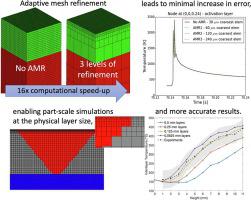当前位置:
X-MOL 学术
›
Comp. Mater. Sci.
›
论文详情
Our official English website, www.x-mol.net, welcomes your
feedback! (Note: you will need to create a separate account there.)
Towards improved speed and accuracy of laser powder bed fusion simulations via multiscale spatial representations
Computational Materials Science ( IF 3.1 ) Pub Date : 2021-02-01 , DOI: 10.1016/j.commatsci.2020.110112 Rishi K. Ganeriwala , Neil E. Hodge , Jerome M. Solberg
Computational Materials Science ( IF 3.1 ) Pub Date : 2021-02-01 , DOI: 10.1016/j.commatsci.2020.110112 Rishi K. Ganeriwala , Neil E. Hodge , Jerome M. Solberg

|
Abstract Due to the growing popularity of laser powder bed fusion (LPBF) as a metal additive manufacturing technique, there is a strong need to be able to accurately predict build outcomes. Full fidelity simulations of this process are not feasible due to the vast range of length and time scales inherent to it. While part-scale codes for simulating residual stress and distortion have shown reasonable predictive capability, they often neglect many aspects of the process occurring over smaller length/time scales, and thus are unable to capture effects of process parameter adjustments or the behavior of fine features. One way of capturing aspects at more refined length scales is through the use of adaptive mesh refinement (AMR). AMR allows for the process to be simulated at scales approaching the physical spatial dimensions without drastically increasing the total degrees of freedom in the simulation. This manuscript describes the implementation of an AMR algorithm within a multiphysics, parallelized finite element code, and its application to the LPBF problem. Part-scale examples are provided where the use of AMR has allowed for higher fidelity thermal and thermomechanical simulations, as compared to experimental measurements. Results from these higher resolution simulations show that while AMR is a necessary component for increased accuracy in a computationally efficient manner, other improvements are also necessary, including handling of the multiple time scales inherent to the problem and the need for improved AM-specific material models.
中文翻译:

通过多尺度空间表示提高激光粉末床融合模拟的速度和准确性
摘要 由于激光粉末床融合 (LPBF) 作为金属增材制造技术的日益普及,迫切需要能够准确预测构建结果。由于该过程固有的大范围长度和时间尺度,因此该过程的全保真模拟是不可行的。虽然用于模拟残余应力和变形的零件规模代码已显示出合理的预测能力,但它们往往忽略了在较小长度/时间尺度上发生的过程的许多方面,因此无法捕捉过程参数调整的影响或精细特征的行为. 在更精细的长度尺度上捕获方面的一种方法是使用自适应网格细化 (AMR)。AMR 允许在接近物理空间维度的尺度上模拟过程,而不会显着增加模拟中的总自由度。这份手稿描述了 AMR 算法在多物理场、并行化有限元代码中的实现,及其在 LPBF 问题中的应用。提供了部分规模的示例,其中与实验测量相比,AMR 的使用允许更高保真度的热和热机械模拟。这些更高分辨率模拟的结果表明,虽然 AMR 是以计算高效的方式提高精度的必要组成部分,但其他改进也是必要的,包括处理问题固有的多个时间尺度以及需要改进 AM 特定材料模型.
更新日期:2021-02-01
中文翻译:

通过多尺度空间表示提高激光粉末床融合模拟的速度和准确性
摘要 由于激光粉末床融合 (LPBF) 作为金属增材制造技术的日益普及,迫切需要能够准确预测构建结果。由于该过程固有的大范围长度和时间尺度,因此该过程的全保真模拟是不可行的。虽然用于模拟残余应力和变形的零件规模代码已显示出合理的预测能力,但它们往往忽略了在较小长度/时间尺度上发生的过程的许多方面,因此无法捕捉过程参数调整的影响或精细特征的行为. 在更精细的长度尺度上捕获方面的一种方法是使用自适应网格细化 (AMR)。AMR 允许在接近物理空间维度的尺度上模拟过程,而不会显着增加模拟中的总自由度。这份手稿描述了 AMR 算法在多物理场、并行化有限元代码中的实现,及其在 LPBF 问题中的应用。提供了部分规模的示例,其中与实验测量相比,AMR 的使用允许更高保真度的热和热机械模拟。这些更高分辨率模拟的结果表明,虽然 AMR 是以计算高效的方式提高精度的必要组成部分,但其他改进也是必要的,包括处理问题固有的多个时间尺度以及需要改进 AM 特定材料模型.











































 京公网安备 11010802027423号
京公网安备 11010802027423号